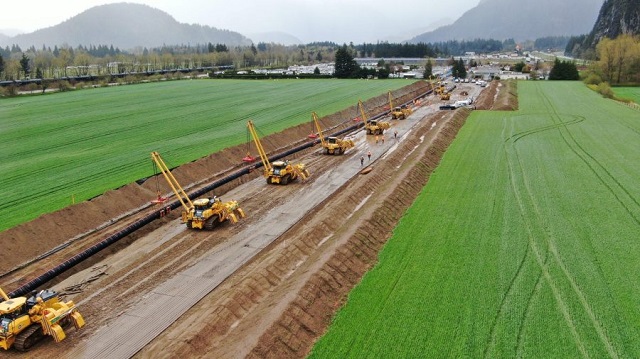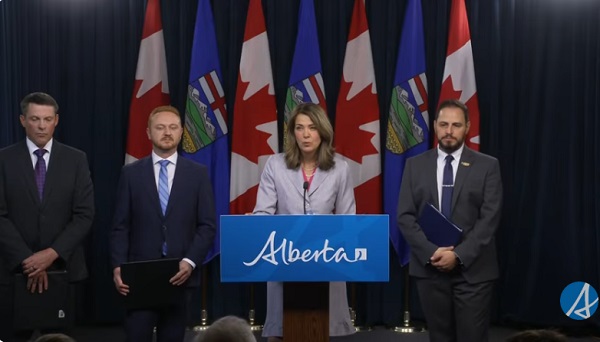Alberta
Trudeau-appointed judge sentences Freedom Convoy-inspired protesters to 6 years in prison
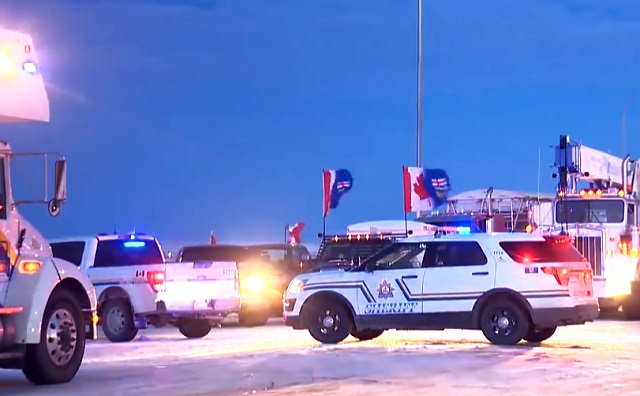
From LifeSiteNews
Justice David Labrenz sentenced Anthony Olienick and Chris Carbert, who were charged with mischief and weapons offenses during the 2022 Freedom Convoy-inspired border blockade in Alberta.
A Trudeau-appointed judge serving in an Alberta court has sentenced two men linked to the 2022 Freedom Convoy-inspired border blockade protest in Coutts, Alberta, to six years in prison.
On September 9, Alberta Court of King’s Bench Justice David Labrenz sentenced Anthony Olienick and Chris Carbert, who were convicted of mischief and weapons offenses stemming from the Coutts border blockade, to six years in prison.
“Stay strong, live free, spread love – not war,” Olienick declared before being sentenced.
“I’ve gained a stronger understanding into what divine destiny awaits me,” he added. “I will continue to help others spreading truth, happiness and joy. Unifying people together by using love as my solemn weapon.”
Labrenz, who was appointed to the Alberta bench by Prime Minister Justin Trudeau in 2018, sentenced Olienick to six years but gave Carbert an additional six months, putting his sentence at six and a half years. However, neither man is expected to serve their full sentence, as both were issued four years of credit for time already served. Both are also prohibited from owning firearms for life, and are required to provide a DNA sample.
Both men have been jailed since February 2022 when they were charged with conspiracy to commit murder during the protest in Coutts, which ran parallel to but was not officially affiliated with, the Freedom Convoy taking place in Ottawa.
Earlier in August, they were finally acquitted of the conspiracy to commit murder charge, but were still found guilty of the lesser charges of unlawful possession of a firearm for a dangerous purpose and mischief over $5,000. Olienick was also found guilty of unlawful possession of an explosive device.
At the time, police said they had discovered firearms, 36,000 rounds of ammunition, and industrial explosives at Olienick’s home. However, the guns were legally obtained and the ammunition was typical of those used by rural Albertans. Similarly, Olienick explained that the explosives were used for mining gravel.
The men were arrested alongside Christopher Lysak and Jerry Morin, with the latter two pleading guilty to lesser charges to avoid trial. At the time, the “Coutts Four” were painted as dangerous terrorists and their arrest was used as justification for the invocation of the Emergencies Act by the Trudeau government, which allowed it to use draconian measures to end both the Coutts blockade and the much larger Freedom Convoy occurring thousands of kilometers away in Ottawa.
Under the EA, the Trudeau government froze the bank accounts of Canadians who donated to the protest. Trudeau revoked the EA on February 23 after the protesters had been cleared out. At the time, seven of Canada’s 10 provinces opposed Trudeau’s use of the EA.
Since then, Federal Court Justice Richard Mosley ruled that Trudeau was “not justified” in invoking the Emergencies Act, a decision which the federal government is appealing.
As LifeSiteNews previously reported, Labrenz’s decision follows a recommendation from the Crown prosecutor for each of the men to serve nine years in prison.
Many Canadians online are condemning the ruling, arguing that the men are being treated in a way that is comparable to political prisoners in communist countries.
“Unbelievable. They made an example out of them. Canada is gone as we know it,” one user lamented.
Others questioned why the two Alberta men were denied bail for two years while dangerous criminals are allowed to roam free under the Trudeau government’s “catch and release” policy.
“Meanwhile, a guy out on parole for assault (and 60+ other “police interactions”) cut off one man’s head and another’s hand in broad daylight in downtown Vancouver…” one commented.
Indeed, this policy has put many Canadians in danger, as was the case last month when a Brampton man charged with sexually assaulting a 3-year-old was reportedly out on bail for an October 2022 incident in which he was charged with assault with a dangerous weapon and possession of a dangerous weapon.
Alberta
Gondek’s exit as mayor marks a turning point for Calgary

This article supplied by Troy Media.
The mayor’s controversial term is over, but a divided conservative base may struggle to take the city in a new direction
Calgary’s mayoral election went to a recount. Independent candidate Jeromy Farkas won with 91,112 votes (26.1 per cent). Communities First candidate Sonya Sharp was a very close second with 90,496 votes (26 per cent) and controversial incumbent mayor Jyoti Gondek finished third with 71,502 votes (20.5 per cent).
Gondek’s embarrassing tenure as mayor is finally over.
Gondek’s list of political and economic failures in just a single four-year term could easily fill a few book chapters—and most likely will at some point. She declared a climate emergency on her first day as Calgary’s mayor that virtually no one in the city asked for. She supported a four per cent tax increase during the COVID-19 pandemic, when many individuals and families were struggling to make ends meet. She snubbed the Dec. 2023 menorah lighting during Hanukkah because speakers were going to voice support for Israel a mere two months after the country was attacked by the bloodthirsty terrorist organization Hamas. The
Calgary Party even accused her last month of spending over $112,000 in taxpayers’ money for an “image makeover and brand redevelopment” that could have benefited her re-election campaign.
How did Gondek get elected mayor of Calgary with 176,344 votes in 2021, which is over 45 per cent of the electorate?
“Calgary may be a historically right-of-centre city,” I wrote in a recent National Post column, “but it’s experienced some unusual voting behaviour when it comes to mayoral elections. Its last three mayors, Dave Bronconnier, Naheed Nenshi and Gondek, have all been Liberal or left-leaning. There have also been an assortment of other Liberal mayors in recent decades like Al Duerr and, before he had a political epiphany, Ralph Klein.”
In fairness, many Canadians used to support the concept of balancing their votes in federal, provincial and municipal politics. I knew of some colleagues, friends and family members, including my father, who used to vote for the federal Liberals and Ontario PCs. There were a couple who supported the federal PCs and Ontario Liberals in several instances. In the case of one of my late
grandfathers, he gave a stray vote for Brian Mulroney’s federal PCs, the NDP and even its predecessor, the Co-operative Commonwealth Federation.
That’s not the case any longer. The more typical voting pattern in modern Canada is one of ideological consistency. Conservatives vote for Conservative candidates, Liberals vote for Liberal candidates, and so forth. There are some rare exceptions in municipal politics, such as the late Toronto mayor Rob Ford’s populistconservative agenda winning over a very Liberal city in 2010. It doesn’t happen very often these days, however.
I’ve always been a proponent of ideological consistency. It’s a more logical way of voting instead of throwing away one vote (so to speak) for some perceived model of political balance. There will always be people who straddle the political fence and vote for different parties and candidates during an election. That’s their right in a democratic society, but it often creates a type of ideological inconsistency that doesn’t benefit voters, parties or the political process in general.
Calgary goes against the grain in municipal politics. The city’s political dynamics are very different today due to migration, immigration and the like. Support for fiscal and social conservatism may still exist in Alberta, but the urban-rural split has become more profound and meaningful than the historic left-right divide. This makes the task of winning Calgary in elections more difficult for today’s provincial and federal Conservatives, as well as right-leaning mayoral candidates.
That’s what we witnessed during the Oct. 20 municipal election. Some Calgary Conservatives believed that Farkas was a more progressive-oriented conservative or centrist with a less fiscally conservative plan and outlook for the city. They viewed Sharp, the leader of a right-leaning municipal party founded last December, as a small “c” conservative and much closer to their ideology. Conversely, some Calgary Conservatives felt that Farkas, and not Sharp, would be a better Conservative option for mayor because he seemed less ideological in his outlook.
When you put it all together, Conservatives in what used to be one of the most right-leaning cities in a historically right-leaning province couldn’t decide who was the best political option available to replace the left-wing incumbent mayor. Time will tell if they chose wisely.
Fortunately, the razor-thin vote split didn’t save Gondek’s political hide. Maybe ideological consistency will finally win the day in Calgary municipal politics once the recount has ended and the city’s next mayor has been certified.
Michael Taube is a political commentator, Troy Media syndicated columnist and former speechwriter for Prime Minister Stephen Harper. He holds a master’s degree in comparative politics from the London School of Economics, lending academic rigour to his political insights.
Troy Media empowers Canadian community news outlets by providing independent, insightful analysis and commentary. Our mission is to support local media in helping Canadians stay informed and engaged by delivering reliable content that strengthens community connections and deepens understanding across the country
Alberta
From Underdog to Top Broodmare

WATCH From Underdog to Top Broodmare (video)
Executive Producers Jeff Robillard (Horse Racing Alberta) and Mike Little (Shinelight Entertainment)
What began as an underdog story became a legacy of excellence. Crackers Hot Shot didn’t just race — she paved the way for future generations, and in doing so became one of the most influential producers the province has known.
The extraordinary journey of Crackers Hot Shot — once overlooked, now revered — stands as one of Alberta’s finest success stories in harness racing and breeding.
Born in humble circumstances and initially considered rough around the edges, Crackers Hot Shot overcame long odds to carve out a career that would forever impact the province’s racing industry. From a “wild, unhandled filly” to Alberta’s “Horse of the Year” in 2013, to producing foals who carry her spirit and fortitude into future generations.
Her influence ripples through Alberta’s racing and breeding landscape: from how young stock are prepared, to the aspirations of local breeders who now look to “the mare that did it” as proof that world-class talent can emerge from Alberta’s paddocks.
“Crackers Hot Shot, she had a tough start. She wasn’t much to look at when we first got her” — Rod Starkewski
“Crackers Hot Shot was left on her own – Carl Archibald heard us talking, he said ‘I’ll go get her – I live by there’. I think it took him 3 days to dig her out of the snow. She was completely wild – then we just started working on her. She really needed some humans to work with her – and get to know that people are not scary.” — Jackie Starkewski
“Crackers Hot Shot would be one of the top broodmares in Albeta percentage wise if nothing else. Her foals hit the track – they’re looking for the winners circle every time.” — Connie Kolthammer
Visit thehorses.com to learn more about Alberta’s Horse Racing industry.
-

 Alberta1 day ago
Alberta1 day agoFrom Underdog to Top Broodmare
-

 International2 days ago
International2 days agoPrince Andrew banished from the British monarchy
-

 Business2 days ago
Business2 days ago“We have a deal”: Trump, Xi strike breakthrough on trade and fentanyl
-

 Alberta2 days ago
Alberta2 days agoProvince orders School Boards to gather data on class sizes and complexity by Nov 24
-
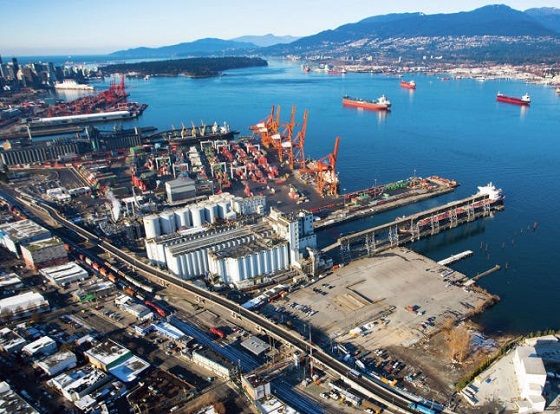
 Crime2 days ago
Crime2 days agoCanada Seizes 4,300 Litres of Chinese Drug Precursors Amid Trump’s Tariff Pressure Over Fentanyl Flows
-

 National2 days ago
National2 days agoWatchdog Presses Ottawa to Release Hidden Lobbying Rulings
-
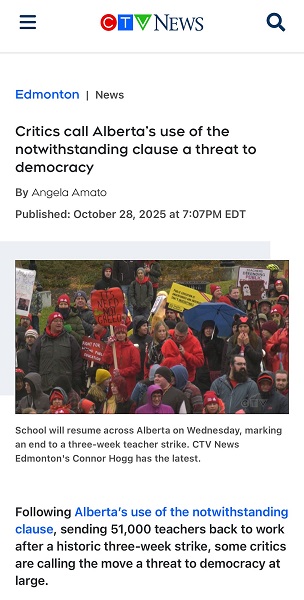
 Alberta2 days ago
Alberta2 days agoHow one major media torqued its coverage – in the take no prisoners words of a former Alberta premier
-

 International1 day ago
International1 day agoNetanyahu orders deadly strikes on Gaza with over 100 dead despite ceasefire deal





